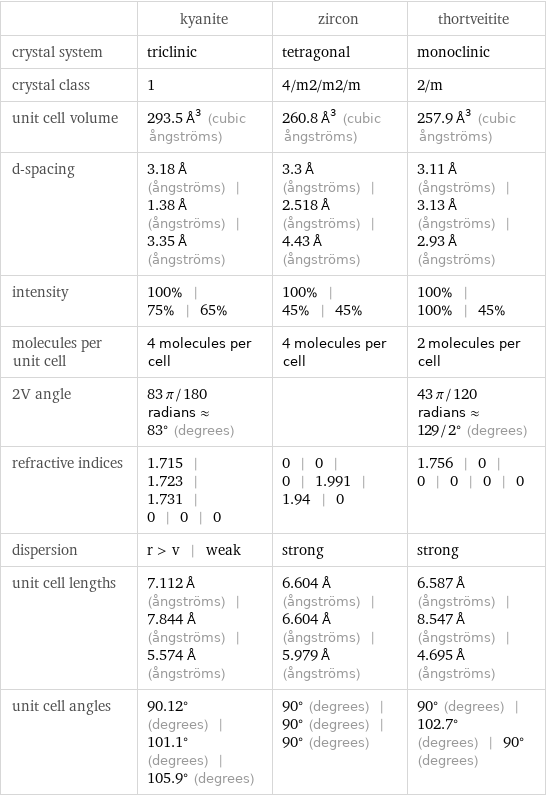Input interpretation

kyanite (mineral) | zircon (mineral) | thortveitite (mineral)
Images

Images
General properties
![| kyanite | zircon | thortveitite alternate names | cyanite | distene | disthene | rhaeticite | azorite | cyrtolite | (none) formula | Al_2SiO_5=Al[6]Al[6]OSiO_4 | ZrSiO_4 | (Sc, Y)_2Si_2O_7 discovery year | | | 1911](../image_source/6d1394e9671a0feba560a4e74d2252b7.png)
| kyanite | zircon | thortveitite alternate names | cyanite | distene | disthene | rhaeticite | azorite | cyrtolite | (none) formula | Al_2SiO_5=Al[6]Al[6]OSiO_4 | ZrSiO_4 | (Sc, Y)_2Si_2O_7 discovery year | | | 1911
Basic properties

| kyanite | zircon | thortveitite density | 3.615 g/cm^3 | 4.65 g/cm^3 | 3.5 g/cm^3 transparency | translucent | transparent | transparent | translucent | opaque | translucent | opaque birefringence | 0.0155 | 0.051 | 0.053 luster | vitreous | pearly | adamantine | vitreous | greasy | vitreous | waxy Mohs hardness | 11/2 | 7.5 | 13/2 tenacity | | brittle | streak | white | white | gray magnetism | nonmagnetic | nonmagnetic | nonmagnetic color | blue | white | gray | green | black | brown | reddish brown | colorless | gray | green | brown | grayish black | black | grayish green fracture | brittle | uneven | conchoidal molar mass | 162.1 g/mol | 183.3 g/mol | 280.1 g/mol
Units

Mineral identifiers

| kyanite | zircon | thortveitite Strunz ID | VIII/B.02-40 | VIII/A.09-10 | VIII/C.01-10 Dana ID | 52.2.2c.1 | 51.5.2.1 | 55.2.1a.4 ICSD number | | | ICSD75925
Crystallographic properties

| kyanite | zircon | thortveitite crystal system | triclinic | tetragonal | monoclinic crystal class | 1 | 4/m2/m2/m | 2/m unit cell volume | 293.5 Å^3 (cubic ångströms) | 260.8 Å^3 (cubic ångströms) | 257.9 Å^3 (cubic ångströms) d-spacing | 3.18 Å (ångströms) | 1.38 Å (ångströms) | 3.35 Å (ångströms) | 3.3 Å (ångströms) | 2.518 Å (ångströms) | 4.43 Å (ångströms) | 3.11 Å (ångströms) | 3.13 Å (ångströms) | 2.93 Å (ångströms) intensity | 100% | 75% | 65% | 100% | 45% | 45% | 100% | 100% | 45% molecules per unit cell | 4 molecules per cell | 4 molecules per cell | 2 molecules per cell 2V angle | 83 π/180 radians≈83° (degrees) | | 43 π/120 radians≈129/2° (degrees) refractive indices | 1.715 | 1.723 | 1.731 | 0 | 0 | 0 | 0 | 0 | 0 | 1.991 | 1.94 | 0 | 1.756 | 0 | 0 | 0 | 0 | 0 dispersion | r > v | weak | strong | strong unit cell lengths | 7.112 Å (ångströms) | 7.844 Å (ångströms) | 5.574 Å (ångströms) | 6.604 Å (ångströms) | 6.604 Å (ångströms) | 5.979 Å (ångströms) | 6.587 Å (ångströms) | 8.547 Å (ångströms) | 4.695 Å (ångströms) unit cell angles | 90.12° (degrees) | 101.1° (degrees) | 105.9° (degrees) | 90° (degrees) | 90° (degrees) | 90° (degrees) | 90° (degrees) | 102.7° (degrees) | 90° (degrees)
Wikipedia summary
Kyanite

Kyanite is typically a blue aluminosilicate mineral, usually found in aluminium-rich metamorphic pegmatites and/or sedimentary rock. Kyanite in metamorphic rocks generally indicates pressures higher than four kilobars. It is commonly found in quartz. Although potentially stable at lower pressure and low temperature, the activity of water is usually high enough under such conditions that it is replaced by hydrous aluminosilicates such as muscovite, pyrophyllite, or kaolinite. Kyanite is also known as disthene, rhaeticite and cyanite.
Zircon

Zircon is a mineral belonging to the group of nesosilicates. Its chemical name is zirconium silicate, and its corresponding chemical formula is ZrSiO_4. A common empirical formula showing some of the range of substitution in zircon is (Zr_(1-y), REE_y)(SiO_4)_(1-x)(OH)_(4x-y). Zircon forms in silicate melts with large proportions of high field strength incompatible elements. For example, hafnium is almost always present in quantities ranging from 1 to 4%. The crystal structure of zircon is tetragonal crystal system. The natural colour of zircon varies between colourless, yellow-golden, red, brown, blue and green.
Thortveitite

Thortveitite is a mineral consisting of scandium yttrium silicate (Sc, Y)_2Si_2O_7. It is the primary source of scandium. Occurrence is in granitic pegmatites. It was named after Olaus Thortveit, a Norwegian engineer. It is grayish-green, black or gray in color.